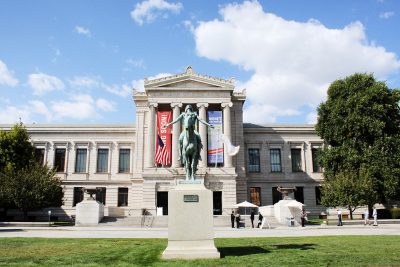The Museum of Fine Arts, one of the most comprehensive art museums in the world with more than 450,000 pieces of art, is reopening to the public on Saturday — for the first time since it closed in March due to the pandemic.

Boston University students, who are offered free membership to the MFA through the BU Arts Initiative, will once again be able to walk through Fenway’s high-ceilinged, marble-walled building. Visitors will have to comply with numerous precautions in place to mitigate the spread of COVID-19.
Masks and social distancing are required, as are advanced timed-entry tickets. Visitors must buy tickets ahead of time, as the museum is not allowing ticket purchase at the door. Groups larger than six are not permitted, and coat checks are no longer available. Visitors will also be asked to complete a health check upon arrival, and must follow designated way-finding paths throughout the museum.
Mike Tom, the MFA public relations associate, wrote in an email that in addition to these guidelines, the museum has taken other measures to increase safety, including heating, ventilation, and air conditioning upgrades.
“The MFA created a new position, the MFA Safety Officer, to oversee new health and safety measures for MFA staff, members and visitors,” Tom wrote. “HVAC systems throughout the building underwent a comprehensive analysis and were upgraded accordingly.”
The new rules preventing groups larger than six will put a halt on BU Arts Insiders leaders like Angel Kim from bringing groups to the museum for tours. Through the BU Arts Initiative, Arts Insiders allows students to attend events in Boston for free as a group.
Kim, a junior in the College of Communication, said she and other enthusiasts are now more restricted in where and how they can appreciate art.
“People who are interested in the arts will have to do their research ahead, instead of just checking it out for fun,” Kim said. “They have to look up their website and then absolutely know the rules in advance.”
Because of this, the museum-going experience will look different this year. However, Maggie Scott, the MFA’s new Safety Officer, said certain aspects will be enhanced to make up for some of the drawbacks of social distancing, advanced time-entry tickets and way-finding. One major change was implementing a virtual in-app placard displaying artists’ names and information about each piece of art.
“All of the labels are going to be on an app that people will be able to access. They’ll also be able to eventually access it in multiple languages,” she said. “This was something that we always wanted to do, but now with the motivation of not wanting people to crowd around a label, we’ve been able to really lean into that goal.”
Scott is in charge of tracking the coronavirus within the state and city, and has worked over the past months to create protocols that include changing the floor plans of the museum in staff and visitor areas.
As the museum worked to reopen, Scott said the MFA collaborated closely with fellow cultural institutions such as the Isabella Stewart Gardner Museum, the New England Aquarium and the Institute for Contemporary Art. It also worked with experts at Northeastern University and Harvard University to prepare for a safe reopening.
“That’s one of the silver linings of what has happened, was the relationships that we’ve been able to build across the sector,” Scott said. “I think that has been really vital to everyone’s success.”
While closed, the MFA also underwent internal changes to promote equity as well as external changes to the building itself.
Internally, the MFA appointed Rosa Rodriguez-Williams as its first senior director of belonging and inclusion. Rodriguez-Williams’ role will be to prioritize the MFA’s promise to be a museum for all of Boston.
Physically, Scott said, some paintings have come down, while others have gone up. Removals included John Singleton Copley’s portrait of King George IV, which visitors may remember hanging in the entryway of the first floor of the American Wing. A wall text panel with a variety of languages will replace the painting.
New works of art going up in the American Wing include Charles Bird King’s portrait of the Pawnee leader Peskelechaco as well as portraits painted by the first free black portrait painter.
Additionally, the Art of the Americas Multilingual Interpretation Initiative will bring translations in Chinese, Spanish, Haitian Creole and an Algonquian language to the American Wing’s opening gallery.
As the museum reopens, visitors can look forward to these changes as well as to upcoming exhibits including “Writing the Future: Basquiat and the Hip-Hop Generation” and “Monet and Boston: Lasting Impression.”
The museum’s closing in March halted some of the artwork for months in cities across the country. Scott said this made the exhibition setup more difficult, as all of the artwork is on loan to the museum.
As a result, the MFA had to renegotiate the contracts for the amount of time the artwork would be on loan. The final result, Scott said, will be “a real triumph for the curator, for the museum, for the artists.”




